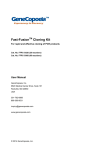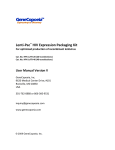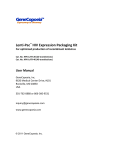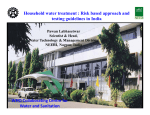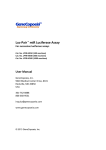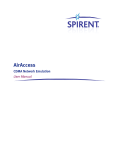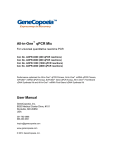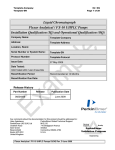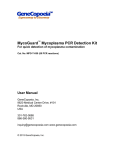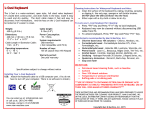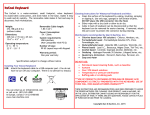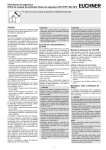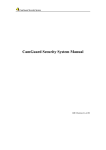Download Fast-FusionTM Cloning Kit
Transcript
Fast-FusionTM Cloning Kit For rapid and effective cloning of PCR products Cat. No. FFPC-C020 (20 reactions) Cat. No. FFPC-C060 (60 reactions) User Manual GeneCopoeia, Inc. 9620 Medical Center Drive, Suite 101 Rockville, MD 20850 USA 301-762-0888 866-360-9531 [email protected] www.genecopoeia.com © 2014 GeneCopoeia, Inc. Fast-FusionTM Cloning Kit User Manual User Manual Fast-FusionTM Cloning Kit I. Introduction II. Contents and Storage III. Key Steps IV. Cloning Reaction and Transformation Procedure V. Troubleshooting VI. Accessories VII. Limited Use License and Warranty I. Introduction The GeneCopoeia Fast-FusionTM Cloning Kit provides a rapid method for cloning your PCR products. In just 15 minutes at room temperature, any PCR fragment can be cloned into your linearized vector at will. After a simple clean up step, a PCR-generated DNA fragment or other purified DNA fragment can be joined to a vector with overlapping ends (Fig.1). Up to eight DNA fragments can be joined together in a single reaction. Well-prepared vectors generate almost 100% positive clones. There are no restriction sites required at the junction site. Therefore, your fragment of interest can be inserted at any position in the vector. The linearized vector can be generated by either PCR or restriction enzyme digestion. The PCR products can be produced by either Taq DNA polymerase or other high fidelity DNA polymerase. Fig.1. Experimental workflow of single fragment insertion into a vector using the GeneCopoeia Fast-FusionTM Cloning Kit. 1 Fast-FusionTM Cloning Kit User Manual Working principle The GeneCopoeia Fast-Fusion TM Cloning Kit inserts the fragment into the vector using two simultaneous steps: a. homology recognition; b. strand exchange and redundant strand degradation. The gaps remaining in the recombinant strands will be repaired by E. coli after transformation. Key Advantages Fast and simple—1 minute for operation and 15 minutes for incubation at room temperature. High efficiency—Greater than 90% of colonies after transformation contain the correct insert(s). High adaptability — No restriction or recombination sites needed, insert fragments generated by either PCR or restriction enzyme digestion can be used. Flexibility—Multiple inserts can be assembled in one reaction. Suitable for multi-site mutagenesis. Seamless construction—Final constructs have no extra base pairs remaining. Protocol overview II. Contents and Storage Contents and storage recommendations for the GeneCopoeia Fast-FusionTM Cloning Kit (Cat.Nos.FFPC-C020 and FFPC-C060) are provided in the following table. Contents Fast-FusionTM Clonase 10 × Clonase Buffer QP Reagent TE Buffer Linearized pUC19 (50 ng/μL) Positive Insert (100 ng/μL) Quantity 1 × 20 μL 3 × 20 μL 1 × 20 μL 3 × 20 μL 1 × 500 μL 3 × 500 μL 1 × 500 μL 3 × 500 μL 1 × 10 μL 3 × 10 μL 1 × 10 μL 3 × 10 μL Shipping temperature Dry ice or ice pack Dry ice or ice pack Dry ice or ice pack Dry ice or ice pack Dry ice or ice pack Dry ice or ice pack 2 Storage temperature -20°C Stable for at least 12 months -20°C Stable for at least 12 months -20°C Stable for at least 12 months -20°C Stable for at least 12 months -20°C Stable for at least 12 months -20°C Stable for at least 12 months Fast-FusionTM Cloning Kit User Manual Additional materials required but not provided Clonable plasmid vector Taq or other high fidelity DNA polymerases DNA quantitation standard Restriction enzymes Gel purification kit Competent cells for transformation S.O.C. medium LB plates with antibiotics III. Key Steps 1. Vector preparation: A well-prepared vector can reduce your screening time. Single enzyme-digested vectors will self-ligate resulting in a high background of plasmids lacking inserts following transformation. The best way to avoid this is to digest with two restriction enzymes, followed by gel purification of the vector backbone. For PCR-generated vectors, we recommend digestion with Dpn I which will destroy plasmids that have been Dam methylated by replication in E. coli. Transform 50-100 μL of competent cells with 5-10 ng linearized vector as a negative control to determine the transformation background. 2. Primer design: Primer design is critical for successful Fast-FusionTM cloning. Homology must present at the ends you want to fuse, e.g. vector and insert (or multiple inserts). Check your primers following the guidelines below. (1) Each Fast-Fusion primer consists of two parts: 1) A sequence at the 5’-end that is homologous to one end of the target vector or another insert, and 2) a gene-specific sequence at the 3’-end that will specifically amplify the target insert (Fig.3, 4). (2) For homologies less than 15 bp, the transformation efficiency will vary depending on DNA structure (Fig.2). GeneCopoeia strongly recommends including more than 15 bp of homology at each end for best results. (3) Avoid complementarity within each primer to prevent hairpin structures, and between primer pairs to avoid primer dimers. (4) The melting temperature (Tm) should be calculated based on the 3’-end (gene specific sequence) of the primer, not the entire primer. GeneCopoeia recommends setting the Tm value of the primer between 55°C -65°C by adjusting the length of the gene specific sequence. Fig.2. Homologies affect cloning efficiency. The number of colonies formed is calculated from 5 ng of pUC19 vector transformed after standard Fast-FusionTM reactions with inserts of indicated homologies (Competent cells efficiency: 2×109cfu/ug). 3 Fast-FusionTM Cloning Kit User Manual Fig.3. Primer with 15 bp homology in different vector ends. Fig.4. Example of primer designed for the GeneCopoeia Fast-Fusion system. Primer sequences are shown in bold. Underlined bases are homologous to the end of pUC19 vector digested by restriction enzyme BamH I. X: bases corresponding to the gene or sequence of interest. 3. PCR amplification and purification: Taq and other high fidelity DNA polymerases are all suitable for generating DNA fragments for Fast-Fusion TM cloning. After PCR, analyze PCR products by electrophoresis on an agarose/EtBr gel. The QP reagent can be used when only a single band is present (Fig.5). Gel purification is strongly recommended when nonspecific amplification is evident. Quantify the purified fragments by measuring against a known DNA standard running in parallel. Fig.5. PCR inserts for Fast-FusionTM cloning. Lane 1: Insert PCR purified by QP reagent. Lane 2: Insert PCR without purification. Lane3, 4: Nonspecific amplification in PCR reaction. 4 Fast-FusionTM Cloning Kit User Manual 4. Use of QP reagent: The QP reagent can precipitate double stranded DNA longer than 100 bp, excluding dNTPs, primers and most of the polymerase. (1) Invert the QP reagent tube several times before use. (2) For 50 μL of PCR product, add TE buffer to 100 μL, followed by addition of 50 μL QP reagent. Mix thoroughly by vortexing for 5 seconds. (3) Centrifuge the mixture at 15,000×g for 15 minutes, and discard the supernatant. Re-centrifuge the tube for 10 seconds and remove all the remaining liquid at the bottom. Note: To obtain better precipitation efficiency for DNA molecules shorter than 200 bp, incubate at 4°C for at least 30 minutes before centrifugation. (4) Re-suspend the DNA by adding 10-20 μL 0.1×TE buffer (diluted with ddH2O). IV. Cloning Reaction and Transformation Procedure 1. Cloning Reaction (1) Set up the following 10 μL cloning reaction on ice. When using the GeneCopoeia Fast-FusionTM Cloning Kit for the first time, GeneCopoeia strongly recommends including positive and negative control reactions in parallel with your cloning reactions. The linearized pUC19 vector and positive insert provided in the kit have already been purified, so there is no treatment needed before use. Reagents Cloning reaction Negative control Positive control Linearized Vector 20-100 ng 1 μL 1 μL linearized pUC19 Target Insert 20-150 ng - 1 μL positive insert 10 × Clonase Buffer 1 μL 1 μL 1 μL Fast-FusionTM Clonase 1 μL 1 μL 1 μL Add ddH2O to 10 μL 7 μL 6 μL ddH2O Note: The recommended molar ratio of insert to vector should be 2-5:1. Use the table below as a guide. Vector (1) Insert Length Scale Length Scale 3k bp 30~50 ng 200-2000 bp 5k bp 40~50 ng 2k-5k bp 100 ng 9k bp 50 ng > 5k bp 100 ng 20-100 ng For multi-insert assembly, reduce scale of each insert. The total scale of vector and inserts should keep around 200ng/10uL as optimal. 5 Fast-FusionTM Cloning Kit User Manual (2) Homogenize the reaction mix by tapping the tube. Centrifuge briefly to collect the liquid at the bottom of the tube. (3) Incubate at 25°C for 15 minutes. (4) Place the tube on ice until transformation. Store the product directly below -20°C do not affect the success rate. [Optional] Add 40 μL TE Buffer to terminate the reaction for long term storage. 2. Transformation Transform competent E. coli cells with your Fast-FusionTM products using the provided protocol (below) or by following the manufacturer’s instructions. GeneCopoeia recommends using high-efficiency competent cells (>108 cfu/μg). (1) Transfer 1 -2 μL of reaction mixture (5-10 μL after dilution with TE Buffer) to 100 μL chemically competent cells. Tap the tube gently for 2~3 times to mix them well. Incubate on ice for 30 minutes. Note: 1 μL is usually sufficient for single-insert cloning. Increase volume for multi-insert assembly. (2) Heat-shock the cells for exactly 30 seconds at 42°C without shaking, then immediately place the tubes on ice for 2 minutes. (3) Add 400 μL of room temperature S.O.C. medium to the cells. (4) Cap the tubes and incubate at 37°C for 1 hour with or without shaking. (5) Spread 50 to 500 μL cells from each tube on pre-warmed LB plates containing the appropriate antibiotics. (6) Incubate plates at 37°C overnight. (7) Pick colonies for analysis. 6 Fast-FusionTM Cloning Kit User Manual V. Troubleshooting The tables below address two main problems encountered during Fast-FusionTM cloning, along with their possible causes and suggested solutions. Please perform the control reactions to confirm that the kit is working properly before you call us for help. 1. Problem: Few or no colonies obtained from transformation. Possibility Competent cells' efficiency is insufficient DNA solution impurity Low DNA concentration in reaction Primer sequences are incorrect Not enough homology Solution Check the control reaction. There should be at least 100 colonies from competent cells with efficiencies greater than 108 cfu/μg Purify the DNA by gel purification, etc. Check with known concentration DNA standards; concentrate the DNA to greater than 20 ng/μL. Check your primers to ensure the products provide corresponding bases of homology. Homologies longer than 20 bp give the best results. Don't use less than 12 bp if your competent cell efficiency is below 109 cfu/μg. Incomplete 3’ ends generated by PCR, Increase the elongation time after the last PCR cycle. Make sure the especially for proofreading polymerases dNTPs in the PCR reaction are not exhausted after PCR cycles. Make sure DNA solution buffer contains no more than 0.2mM EDTA, EDTA repression which will repress the assembly reaction. Dilute TE buffer to 0.1x before using it as DNA solution buffer. Too much homology 2. Increase the incubation time to 30 min for homologies longer than 30 bp. 60 minutes is recommended for homologies longer than 50 bp. Problem: There are many colonies after transformation, but none of the plasmids contain inserts. Possibility Solution Incomplete linearization of vector Digest vector completely; generate incompatible overhangs; gel-purify your digestion product; transform a no-insert control to verify few background colonies can grow. Large amounts of DNA (more than 400 ng) in the reaction will either slow Too much DNA transformed down the reaction or compete with your assembled molecules in transformation. Scale to no more than 200 ng per 100 μL chemically competent cells. Contamination of PCR template carrying 1-10 ng of plasmid template is usually sufficient for PCR reaction. Digest the same antibiotic resistance the plasmid template with Dpn I, or gel-purify the PCR product. Insert : Vector ratio is too low Re-determine the molar ratio, add into the reaction as recommended. Antibiotics expired or incorrect Do an empty incubation in 37°C to make sure the antibiotics are not expired. 7 Fast-FusionTM Cloning Kit User Manual VI. Accessories: Composition of Buffers and Solutions TE Buffer: 10 mM Tris.Cl (pH8.0) 1 mM EDTA (pH8.0) SOC medium (100ml) 2.0g Bacto-tryptone 0.5g Bacto-yeast extract 1ml (1M) EDTA (pH8.0) 0.25 ml (1M) KCl 1ml (1M) NaCl 1ml (2M) glucose, filter-sterilized 1ml (2M) Mg2+stock, filter-sterilized Add Bacto-tryptone, Bacto-yeast extract, NaCl and KCl to 97ml of distilled water. Stir to dissolve.Autoclave and cool to room temperature. Add 2M Mg2+ stock and 2M glucose, each to a final concentration of 20mM. Bring the volume to 100ml with sterile, distilled water. The final pH should be 7.0. 2M Mg2+ stock 20.33 g MgCl2•6H2O 24.65 g MgSO4•7H2O LB medium (per liter) 10 g Bacto-tryptone 5g Bacto-yeast extract 5g NaCl Adjust the pH to 7.5 with NaOH. Autoclave to sterilize. For LB plates, include 15g agar prior to autoclaving. Accessorial products Description GCI-5α Chemically Competent E.coli Cells GCI-L3 Chemically Competent E.coli Cells Catalog# STK200-10 STK200-20 (10 tubes) (20 tubes) STK300-10 STK300-20 (10 tubes) (20 tubes) 8 Fast-FusionTM Cloning Kit User Manual VIII. Limited Use License and Warranty Limited Use License Following terms and conditions apply to use of Fast-FusionTM Cloning Kit (the Product). If the terms and conditions are not acceptable, the Product in its entirety must be returned to GeneCopoeia within 5 calendar days. A limited End-User license is granted to the purchaser of the Product. The Product shall be used by the purchaser for internal research purposes only. The Product is expressly not designed, intended, or warranted for use in humans or for therapeutic or diagnostic use. The Product must not be resold, repackaged or modified for resale, or used to manufacture commercial products without prior written consent from GeneCopoeia. This Product should be used in accordance with the NIH guidelines developed for recombinant DNA and genetic research. Use of any part of the Product constitutes acceptance of the above terms. Limited Warranty GeneCopoeia warrants that the Product meets the specifications described in the accompanying Product Datasheet. If it is proven to the satisfaction of GeneCopoeia that the Product fails to meet these specifications, GeneCopoeia will replace the Product. In the event a replacement cannot be provided, GeneCopoeia will provide the purchaser with a refund. This limited warranty shall not extend to anyone other than the original purchaser of the Product. Notice of nonconforming products must be made to GeneCopoeia within 30 days of receipt of the Product. GeneCopoeia’s liability is expressly limited to replacement of Product or a refund limited to the actual purchase price. GeneCopoeia’s liability does not extend to any damages arising from use or improper use of the Product, or losses associated with the use of additional materials or reagents. This limited warranty is the sole and exclusive warranty. GeneCopoeia does not provide any other warranties of any kind, expressed or implied, including the merchantability or fitness of the Product for a particular purpose. GeneCopoeia is committed to providing our customers with high-quality products. If you should have any questions or concerns about any GeneCopoeia products, please contact us at 301-762-0888. © 20014, GeneCopoeia, Inc. GeneCopoeia, Inc. 9620 Medical Center Drive, Suite 101 Rockville, MD 20850 +1 (301) 762-0888 +1 (866) 360-9531 [email protected] GeneCopoeia Products are for Research Use Only TM TM Copyright © 2014 GeneCopoeia, Inc. TM TM TM Trademarks:GeneCopoeia , OmicsLink , Secrete-Pair , GLuc-ON , miTarget , Fast-Fusion 9 TM (GeneCopoeia Inc). FFPC-140210










